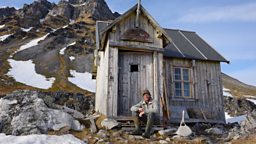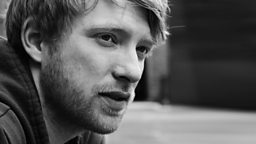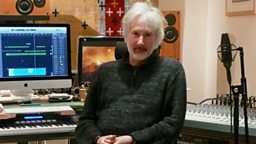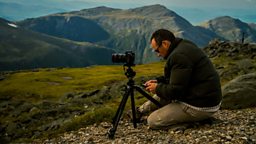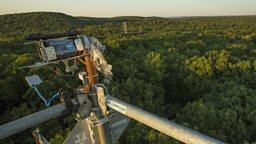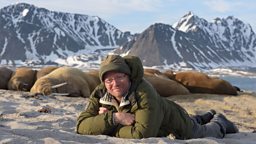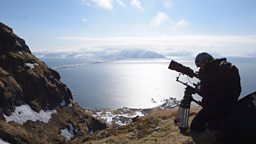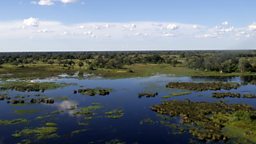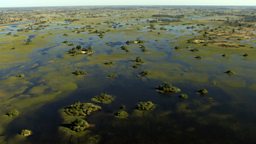Filming a portal to 1980s Russia
by Andrew Murray, producer
Though Svalbard belongs to Norway today, in the past, many nations vied for its rich mineral wealth. Here, Russia built a town for over a thousand coal workers and their families at a frozen end of the Earth. But with the collapse of the Soviet Union it was abandoned, and has remained exactly as it was the day it was left. A ghost town. Somewhere I had read about and desperately wanted to film this town as part of the human landscape thread of my film.
The approach is extraordinary. As you come closer over the flat expanse of the sea ice, a soviet giant of a crane greets you at the frozen dock. Built to load millions of tonnes of coal onto ships in the summer, it now threatens to bend down and snatch you from your snowmobile as you leave the sea ice and wend your way past its giant iron legs and onto solid ground.
As we move on, great concrete accommodation blocks pass on either side and a sign welcomes us in Russian to ‘Pyramiden’, a town named after the pyramidal mountain behind it, from which all the coal was mined. There are a few more classical looking municipal buildings and then at the bottom of a grand formal parade, presided over by a bust of Lenin (face half caked in snow) we park outside one of the Soviet style blocks. Its great bulk is built of bricks but stands on stilts to keep it above the permafrost. The Russians know how to build in the cold. This is where we are going to stay, and this must be our friendly host – Sasha, complete with Russian greatcoat, fur hat and rifle slung over shoulder for defence against polar bears.
As far as we can tell, he and the female cook are the sole inhabitants of Pyramiden today. They run this one block as a hotel for the slowly growing trade in tourists who are curious to see a tiny piece of Soviet Russia preserved in the middle of the arctic. Tonight, we have the choice of a dozen rooms, all very concrete and austere but clean and warm, fuelled no doubt by the leftover coal from the mining days. In the deserted restaurant, complete with intricately carved (polystyrene?) ceiling and part - panelled walls, the three of us are served soup, bread, cheese and salad brought all the way from Russia. The cook appears at the bar to serve us drinks and Sasha showed us where a polar bear had recently climbed through the window into the old museum and snuffled around the stuffed sea birds. Eventually it had crashed through the dining room window which, as Sasha points out, is now boarded up. Sasha needs his gun.
The next day we film the exteriors in rare and beautiful sunlight. A Soviet ghost town against the backdrop of an arctic glacier and a frozen ocean. We then went on to capture some truly evocative scenes inside the buildings. A gym with basket balls lying exactly where they had been left, the cinema projection room with spools of Russian film strewn all over the floor. Plates needing washing up, pot plants un-watered for over thirty years, the Olympic swimming pool. Even the world’s northern – most piano. In its heyday this was not just a mining town, it was something of a soviet showpiece to the rest of the world. Russian life was good, even at the frozen ends of the earth.
Just as we are about to leave, three arctic foxes appeared for our camera. Where Russia once tried to tame the arctic, today, foxes have reclaimed the streets. I imagine that under the shelter of one of these great Russian apartment blocks is a great place for a den. We don’t have time to find out.
As Asgeir and I keep filming these beautiful creatures, in such a nostalgic setting, our guide Tom hurries us to leave. The bad weather is closing in again and we needed to make tracks if we are ever to get back over the pass to Longyearbyen.
An hour later I am blasting through the blizzard chasing Tom’s tail lights, wondering whether somewhere in these remote arctic mountains there is in fact a portal to 1980s Russia.

Russian ghost town
The surreal experience of a 1980s Russian town in a remote corner of Svalbard.
